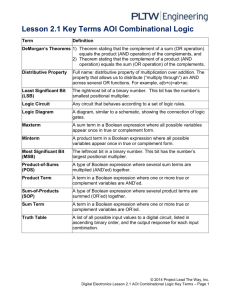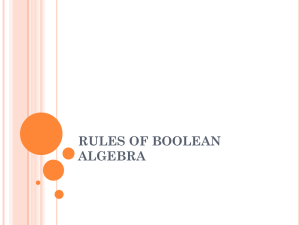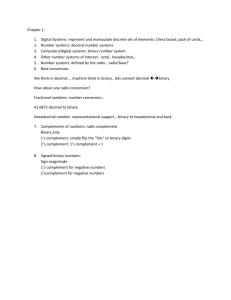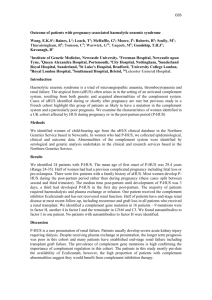Example:- 1 0 1 1 1 * 1 0 1 0 0 0 0 0 0 + 1 0 1 1 1 0 0 0 0 0 1 0 1 1 1
advertisement
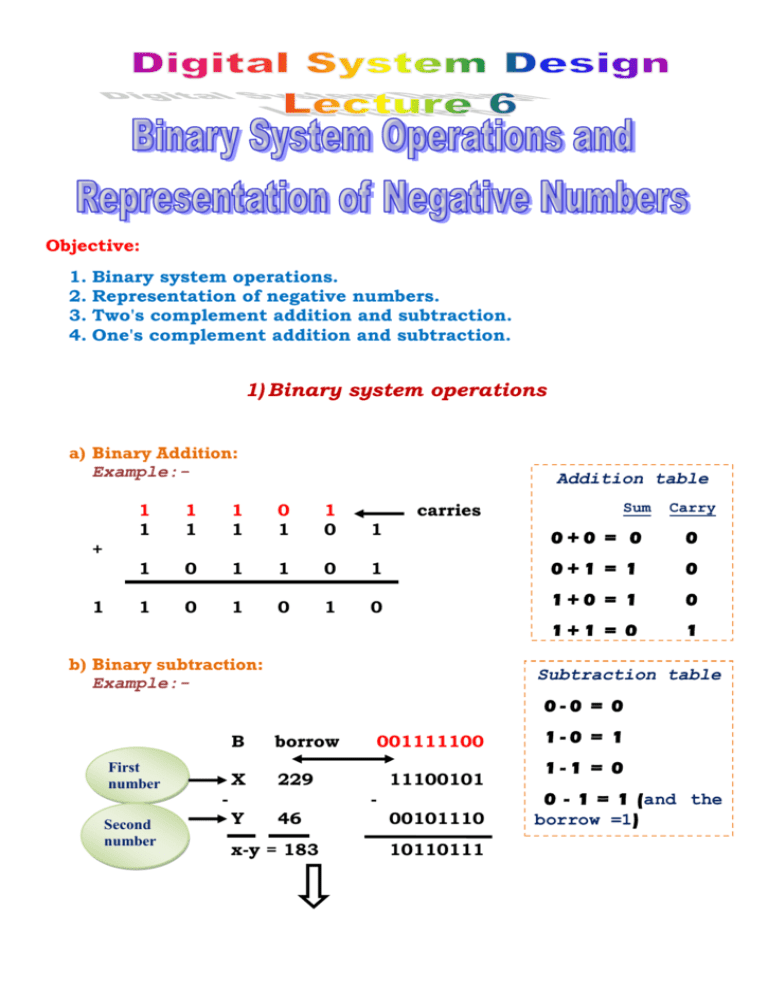
Objective: 1. Binary system operations. 2. Representation of negative numbers. 3. Two's complement addition and subtraction. 4. One's complement addition and subtraction. 1) Binary system operations a) Binary Addition: Example:- Addition table carries Carry 1 1 1 1 0 1 1 0 1 0+0 = 0 0 1 0 1 1 0 1 0+1 = 1 0 1 0 1 0 1 0 1+0 = 1 0 1+1 = 0 1 + 1 Sum 1 1 b) Binary subtraction: Example:- Subtraction table 0-0 = 0 First number Second number B borrow X 229 - 001111100 11100101 - Y 46 x-y = 183 00101110 10110111 1-0 = 1 1-1 = 0 0 - 1 = 1 (and the borrow =1) After the first borrow, the new subtraction for this column is 0-1, so we must borrow again. X 229 0 10 1 1 10 10 1 1 1 0 0 1 0 1 0 0 1 0 1 1 1 0 1 0 1 1 0 1 1 1 Must borrow 1, yielding the new subtraction 10-1 = 1 Y 46 x-y 183 The borrow goes through three columns to reach a borrowable 1. 100 = 011 (the modified bits), + 1 (the borrow) c) Binary multiplication: Example:- Multiplication table 0 1 1 0 1 1 1 0 0*0=0 0 1 0 0 1 1*0=0 1 0 0 0 1 0 1 0 1 0 1 0 0 0 1 1 1 1 0 0 1 1 0 (result) 1 * + 0*1=0 1*1=1 2) Representation of negative numbers There are many ways to represent negative numbers: Signed-magnitude system. Complement number systems. Signed-magnitude representation: In signed-magnitude system, the number consists of a magnitude and a symbol indicating whether the magnitude is positive or negative. In binary system: extra bit position to represent the sign (sign bit): (MSB) is used. Sign bit: 0 = plus, 1 = minus. Example:𝟎 𝟏𝟎𝟏𝟎𝟏𝟎𝟏𝟐 = +𝟖𝟓𝟏𝟎 , 𝟏𝟏𝟎𝟏𝟎𝟏𝟎𝟏𝟐 = −𝟖𝟓𝟏𝟎 Sign bit magnitude 𝟎𝟏𝟏𝟏𝟏𝟏𝟏𝟏𝟐 = +𝟏𝟐𝟕𝟏𝟎 𝟏𝟏𝟏𝟏𝟏𝟏𝟏𝟏𝟐 = −𝟏𝟐𝟕𝟏𝟎 𝟎𝟎𝟎𝟎𝟎𝟎𝟎𝟎𝟐 = +𝟎𝟏𝟎 𝟏𝟎𝟎𝟎𝟎𝟎𝟎𝟎𝟐 = −𝟎𝟏𝟎 Complement number systems: Complement number system negates a number by talking its complement as defined by the system. There are two complement number systems that can be used: o Two's complement system o One's complement system. Two's complement system: The two’s complement of an n-digit number D is obtained by: Subtracting the number from 𝐫 𝐧 𝐫𝐧 − 𝐃 o r- The base of the system. This can be accomplished by complementing the individual digits of D, and adding 1 to the result. In decimal system, it's called the 10's complement. For binary numbers, it's called two's complement. The MSB of a number in this system is used as the sign bit. Example 1: Example 2: 𝟏𝟕𝟏𝟎 = 𝟎𝟎𝟎𝟏𝟎𝟎𝟎𝟏𝟐 −𝟗𝟗𝟏𝟎 = 𝟏𝟎𝟎𝟏𝟏𝟏𝟎𝟏𝟐 Complement bits complement bits 11101110 + 01100010 1 + 11101111 = −𝟏𝟕𝟏𝟎 1 𝟎𝟏𝟏𝟎𝟎𝟎𝟏𝟏𝟐 =𝟗𝟗𝟏𝟎 Example 3: 𝟎𝟏𝟎 = 𝟎𝟎𝟎𝟎𝟎𝟎𝟎𝟎𝟐 11111111 + 1 X 1 𝟎𝟎𝟎𝟎𝟎𝟎𝟎𝟎𝟐 = 𝟎𝟏𝟎 Important Note: The number 0 has one representation using two’s complement. One's complement representation: In one's complement representation the complement of an n-digit number D is obtained by: Subtracting the number from 𝐫 𝐧 –1 (𝐫 𝐧 –1)-D This can be accomplished by complementing the individual digits of D, without adding 1 as in two's complement systems. o In decimal system it's called 9's complement. o In binary system it's called 1's complement. Example 1 𝟏𝟕𝟏𝟎 = 𝟎𝟎𝟎𝟏𝟎𝟎𝟎𝟏𝟐 𝟏𝟏𝟏𝟎𝟏𝟏𝟏𝟎𝟐 = 𝟏𝟕𝟏𝟎 Example 2 −𝟗𝟗𝟏𝟎 = 𝟏𝟎𝟎𝟏𝟏𝟏𝟎𝟎𝟐 𝟎𝟏𝟏𝟎𝟎𝟎𝟏𝟏𝟐 = 𝟗𝟗𝟏𝟎 in one's complement : MSB is used as sign digit. The number 0 has two representations using one’s complement: 00000000 positive zero. 11111111 negative zero. 3) Two's complement addition and subtraction Example 1: adding two positive numbers: +15 +27 + 0 0 0 Sign bit 0000 0001 0010 1111 1011 1010 = (𝟒𝟐)𝟏𝟎 (okay) Example 2: adding two positive numbers with overflow: +78 +85 +78 +85 = (𝟏𝟔𝟑)𝟏𝟎 0 + 0 1 1 1 0 0 0 1 0 1 0 (we need 8 bits +1 for sign bit) 1 0 0 1 1 0 1 0 1 0 1 1 Sign or overflow? Example 3 43 -25: + 1 00101011 11100111 00010010 Ignore Example 4 25- 43: + Example 5 0 1 0011 001 1010 101 1 1101 110 -15 -27: + 1 1 1110001 1100101 1 1010110 1 Ignore 4) One's complement addition and subtraction Note: the same as two's complement addition and subtraction, except that the carry value must be added to the result in LSB bit. Example 1: 43-25: 00101011 + 11100110 (Carry) 100010001 1 (carry added) 00010010 Example 2: 25- 43: 00011001 + 11010100 11101101

